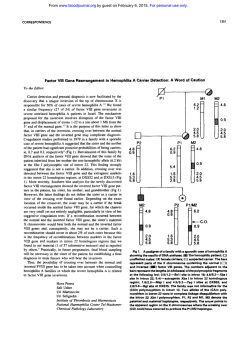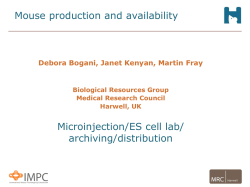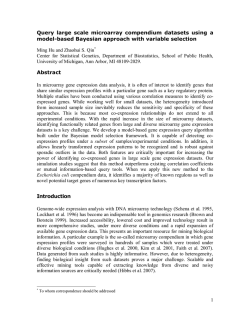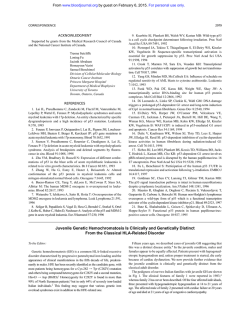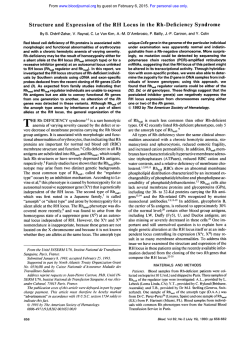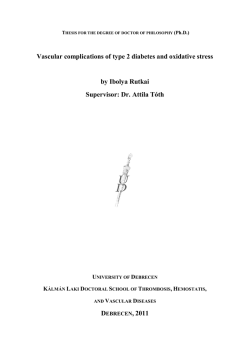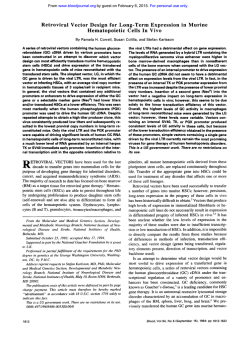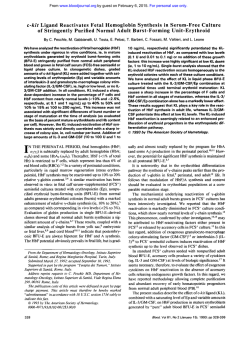
The Pharmacology of Hemoglobin Switching: Of Mice and Men
From www.bloodjournal.org by guest on February 6, 2015. For personal use only. PERSPECTIVE The Pharmacology of Hemoglobin Switching: Of Mice and Men By Timothy J. Ley H OW D O RED BLOOD CELLS (RBCs) switch from fetal to adult-type hemoglobin (Hb)production at the time of birth? The structures of fetal and adult Hbs and the genes that encode them have been known for many years, but this knowledge has not readily yielded the molecular mechanisms underlying the switch. The mysterious switch is a transcriptional one: the fetal (y) globin genes are actively transcribed in fetal RBCs, but in adult RBCs, the P-globin genes are transcribed at a much higher rate than the y-genes.’ Since the discovery of fetal Hbs, investigators have proposed that reactivation of fetal Hb (HbF) synthesis would lessen the severity of diseases caused by P-globin gene mutations. These hopes were further strengthened when normal individuals with large amounts of circulating HbF were identified; these people have “Hereditary Persistance of Fetal Hemoglobin” and no medical problems.’ Preventing or reversing the switch from normal HbF synthesis to defective adult Hb synthesis could, therefore, be a therapeutic goal, because high HbF levels do not cause problems in otherwise normal individuals. But how could this goal be achieved? Remarkable studies over the past decade have taken us closer to an answer. THE METHYLATION HYPOTHESIS Shortly after the human P-like globin genes were cloned and sequenced, van der Ploeg and Flavell correlated the methylation status of DNA sequences near the globin genes and the activities of these genes in different tissues.’ The human y-globin genes were undermethylated in tissues where they were normally expressed (like fetal liver), but were heavily methylated in adult erythroid cells or in non-erythroid tissues. This observation led to the formation of a simple hypothesis: if one could cause DNA near the y-globin genes of adult bone marrow cells to become hypomethylated, these genes might resume transcription and HbF production would increase. Joe DeSimone and Paul Heller seized upon this idea and decided to test it in a primate model of Hb switching that they had developed. They knew that the basic structures of the fetal and adult globin genes of baboons and humans were similar, and From the Division of Hematology-Oncology,Departments of Medicine and Genetics, Jewish Hospital at Washington Universi@Medical Center, St Louis,MO. Submitted December 20, 1990; accepted December 21,1990. Suppored by National Institutes of Health Grants DK38682 and CA49712. Address reprint requests to Timothy J. Ley, MD, Division of Hematology-Oncology,Departments of Medicine and Genetics, Jewish Hospital at Washington University Medical Center, 216 S Kingshighway Blvd, St Louis,MO 63110. 0 1991 by The American Society of Hematology. 0006-4971/91/7706-OO33$3.00l0 1146 proposed that the methylation hypothesis could be directly tested in this model. In the late 1970s and early 1980s, a number of investigators had shown that the drug 5-azacytidine could block the activity of the enzyme that normally methylates newly synthesized DNA, causing the DNA in dividing cells to become hypomethylated? Treatment of tissue culture cells with this drug sometimes activated specific genes and/or specific developmental “programs.” Throughout the 1970s, 5-azacytidine had also been tested in phase I trials of patients with acute non-lymphocyticleukemia. The pharmacology and toxicities of 5-azacytidine were, therefore, well understood in 1981, when this drug was first administered to baboons. In the first experiments with the drug, 5-azacytidine caused tremendous elevations of HbF levels in the phlebotimized baboon^.^ The precise mechanism of y-globin gene activation could not be rapidly determined in baboons, because the structures of all the globin genes was not yet known. In collaboration with DeSimone and Heller, Art Nienhuis and I used the information from the baboon trials to design treatment protocols for human patients with severe sickle cell anemia or p-thalassemia; George Dover and Sam Charache independently treated a group of sickle cell patients at Johns Hopkins at the same time. To our delight, relatively non-toxic doses of 5-azacytidine dramatically increased HbF synthesis in almost all of the individuals who were tested?.’ The drug indeed caused hypomethylation of the newly synthesized DNA found in bone marrow cells.5s6 Despite evidence for widespread DNA hypomethylation, only a restricted cohort of genes (including the y-globin genes) seemed to be activated by the treatment.’ These results suggested that either the y-globin genes were somehow primed to be reactivated in adult bone marrow cells, or that other mechanisms were partially responsible for the augmented HbF synthesis. THE ”ERYTHROID REGENERATION” HYPOTHESIS Observations made in the 1970s by Alter et aI8suggested that erythroid regeneration was associated with an altered “program” of HbF synthesis in erythroid progenitor and precursor cells. Because 5-azacytidine is a cytotoxic compound, Nathan, Stamatoyannopoulos, Papayannopoulou, and their colleagues argued that cytotoxicity and erythroid regeneration may have caused 5-azacytidine’s effects on HbF production: and suggested that alternate cytotoxic drugs (that did not directly inhibit DNA methylation) would have the same effects. Indeed, hydroxyurea and AraC were both shown to increase HbF production in primates and in humans.’”” “Demethylation” of newly synthesized DNA was, therefore, not necessary to augment HbF production. However, in the final analysis, azacytidine still seems to work by both mechanisms: first, it causes newly synthesized bone marrow DNA to become hypomethylated; and, secondly, it is cytotoxi~.’~~’~ B/ood,Vol77,No6(March15),1991: pp1146-1152 From www.bloodjournal.org by guest on February 6, 2015. For personal use only. 1147 HEMOGLOBIN SWITCHING These early experiments with pharmacologic “reverse switching” demonstrated that the switch was “plastic” and could be manipulated. However, all of the drugs used to manipulate the switch were cytotoxic, anti-leukemia drugs with uncertain potentials for causing secondary malignancies if administered over long periods of time. Of the three drugs tested, hydroxyurea had the least clearcut potential for causing harm, and already had a proven safety record in patients with myeloproliferative diseases. For this reason, clinical trials with hydroxyurea have been initiated in patients with sickle cell anemia,17s18 and a phase I11 trial is currently being considered to test its ability to reduce crisis frequency. Nonetheless, long term administration of cytotoxic compounds will never be an ideal therapeutic option for patients with hemoglobinopathies. The ideal pharmacologic compound would obviously have little or no toxicity and would be safe to administer to children during periods of normal growth and development. The search for such a compound has continued to demonstrate the usefulness of large animal models to identify drugs that can alter patterns of globin synthesis in humans. Ginder et all9first demonstrated that embryonic chicken globin genes could be reactivated by administering 5-azacytidine and butyrate compounds to adult chickens. Both drugs were required for the effect, and a “two-hit’’ model for embryonic globin gene reactivation was proposed. In subsequent years, Perrine et almand Bard and Prosmanne” demonstrated that butyrate metabolites were persistently elevated in the infants of diabetic mothers, who undergo delayed HbF switching after birth. Butyrate compounds were subsequently shown to delay the fetal to adult globin switch in developing sheep;’ and to augment HbF production in baboons.= Butyrate compounds have not yet been tested in humans, because safety issues have not yet been addressed. Hematopoietic growth factors can also alter patterns of Hb synthesis. Because erythropoietin administration is known to cause a form of erythropoietic “stress,” Al-khatti et alZ4tested this drug in baboons and detected augmentation of fetal globin synthesis. However, the effect of erythropoietin on HbF production in sickle cell patients has been minimal thus far.” Finally, granulocyte-macrophage colony-stimulatingfactor (GM-CSF) augments HbF production in cultured erythroid progenitors? but its effects on HbF have not yet been tested in animal models. Although almost all of the work regarding pharmacologic manipulation of HbF has been developed in primate or large animal models, these models remain extremely cumbersome and expensive to use. They are not well suited for surveys of compounds, and because of differences between the globin gene clusters of higher primates and humans, not all of the results can be directly extrapolated to humans. A better animal model for testing pharmacologic agents is clearly required; in this issue of Blood, Constantoulakis et aIz6describe a transgenic mouse model that fulfills many of these requirements. To understand this model, a brief review of human globin gene regulation in transgenic mice is useful. DEVELOPMENT AND TISSUE-SPECIFIC EXPRESSION HUMAN GLOBIN GENES IN TRANSGENIC MICE OF Early attempts to study the expression of human globin genes in transgenic mice were at times frustrating, but ultimately, these studies proved to be very informative. When an entire human P-globin gene was integrated into the germline of transgenic mice, only a small proportion of the founder animals expressed the $-globin gene27*28; usually, the P-globin transgene was expressed at much lower levels than the endogenous mouse $-major globin genes. Even so, human $-globin gene sequences targeted expression exclusively to adult erythroid tissues; that is, the DNA sequences required for expression in RBCs at the correct stage of development were present within or near the P-globin gene.27,28 Experiments performed by three separate groups, including Kollias et al,29Behringer et al,M and Trudel et a1,3’ demonstrated that the sequences required for adult erythroid-specific expression were located within and immediately 3’ to the P-globin gene. When human y-globin genes were tested in transgenic mice, a different pattern of expression emerged. When these studies were performed, there was only one recognized murine Hb switch from the embryonic stage (yolk sac) to the adult stage (fetal liver and adult bone marrow). Mice were thought to have embryonic $-like globin genes and adult P-globin genes, but nothing corresponding exactly to the y-globin genes of humans. More recent studies suggest that there may in fact be embryonic-to-fetal and fetal-to-adult switches in the mouse”; regardless, the developmental fate of y-globin transgenes was difficult to predict. To the surprise of most workers in the field, human y-globin transgenes were expressed only at the yolk sac (embryonic) stage of de~elopment!~~.” This finding suggested that the embryonic stage is more akin to the fetal stage of erythroid development in humans, and suggested that “fetal” stage-specific factors were present in the embryonic RBCs of developing mice. In contrast to the human p-globin gene, y-globin sequences required for targeting to embryonic RBCs are located upstream from the y-gene~?’.”’~ However, transgenic mice containing y-globin transgenes behaved similarly to the P-globin transgenics in two regards: first, only a small proportion of the transgenic mice expressed the y-globin transgenes, and, secondly, the level of expression was much lower than that of the embryonic mouse globin gene^."*'^-^^ Certainly all of the early transgenic studies suggested that sequences within or near the y- or P-globin genes were responsible for targeting the expression of these genes to the appropriate tissue at the appropriate developmental stage. These experiments also suggested that additional DNA sequences would be required for high level expression of human globin genes in the erythroid cells of most transgenic mice. THE LOCUS CONTROL REGION (LCR) OF THE P-GLOBIN GENECLUSTER The first clues regarding the nature of these sequences came from the studies of Tuan et a136and Forrester et al?’ who discovered a series of six DNAse I hypersensitive sites From www.bloodjournal.org by guest on February 6, 2015. For personal use only. 1148 TIMOTHY J. LEY located far upstream and far downstream from the human p-like globin gene cluster (see Fig 1). These DNAse I hypersensitive sites were erythroid-specific but developmentally stable; that is, these regions of chromatin were “open” and DNAse I hypersensitive at all stages of erythroid development. Forrester et aI3*went on to show that these DNAse I hypersensitive sites were reconstituted when a non-erythroid human chromosome 11 was transferred into the mouse erythroleukemia cell environment, suggesting that the locus itself contains all of the information required to form an active chromatin domain. They wined the term “locus activation region” (LAR)to describe this function. More recently, Dhar et a139have shown that several of these sites are hypersensitive in non-erythroid and even nonhematopoietic cell lines; only 5’ HS-3 (see Fig 1) is DNAse I hypersensitive only in erythroid cell lines. At about the same time, Grosveld et a1 decided to determine whether DNA sequences derived from this upstream region contained the “missing” information necessary for high level expression of human globin genes in transgenic mice. To their surprise, every transgenic founder line containing a 6-globin gene linked with the far upstream region expressed its transgene at a level that was similar to that of the endogenous mouse p-major genes.39The number of copies of the transgene in the mouse genome was directly correlated with the level of transgene expression. Furthermore, expression of the transgenes did not seem to be dependent on the position of transgene integration. The function of the p-globin transgenes was therefore said to be “position independent” and “copy-number dependent.” Because of the powerful effects of the upstream region, Grosveld called these sequences the dominant cmtrol region (DCR). (Conferees at the 7th Conference on Hemoglobin Switching agreed upon the consensus name “Locus Control Region” [LCR] for this region, and further agreed that the individual DNAse I hypersensitive sites [HS] would be named 5‘ HS-1,2,3,4, and 5 upstream from the €-globin gene, and 3’ HS-1 downstream from the p-globin gene, as indicated in Fig 1). Because of the powerful and interesting activities of the LCR in transgenic mice, a number of laboratories rapidly confirmed and extended these early r e s ~ l f s . ”The ~ ~ ~LCR ~ was shown to activate a-globin gene expression in transgenic mice,”.” suggesting that the a-globin locus on chromosome 16 might also be under the influence of similar sequences (see below). Co-injection of ci- and p-globin 5’HS:5 4 3 2 genes with the LCR has resulted in mice making large quantities of human Hb44345; mice producing HbS have been made by coinjecting a- and p‘-globin genes with the LCR.46,47 The importance of the LCR for P-globin gene function in vivo has also been recently established. Driscoll et ala have identified a 30-kb deletion that removes 5‘ sites 2-5 in an Hispanic patient with ySp thalassemia (Fig 1). The entire p-globin cluster on this chromosome is intact, but none of the genes in the cluster are functional. Forrester et a149have recently shown that this deletion closes the normally open chromatin “domain” of the p-globin gene cluster in erythroid cells, and that it delays the replication of the p-like genes during the cell cycle. Because the region containing the LCR sequences spans a large stretch of DNA, investigators immediately tried to identify the critical functional sequences within this region. Initial studies focused on the DNAse I hypersensitive sites themselves. Accordingly, DNA sequences between the hypersensitive sites were removed in successive deletions creating “mini-LCR” and “micro-LCR” which seemed to retain all of the detectable LCR functions in studies performed with transgenic mice or mouse erythroleukemia cells. DNA sequences near 5‘ HS-2 and -3 have most of the activity in these but 5‘ HS-1 and -4 also seem to have more subtle functions. The combination of all four 5‘ sites is required apparently for full function of the LCR in transgenic mice.”1353 How does the LCR normally function in erythroid precursors? The answer to this question is not yet known, but intense investigations in a number of laboratories have begun to find a number of clues. First, when LCR sequences are integrated into genomic DNA, they seem to be able to open a chromatin domain and keep it open, isolating sequences within the domain from potentially negative influences nearby. The LCR, therefore, seems to increase the number of “productive integration events”; hence, nearly every transgenic mouse containing a P-globin gene linked to an LCR expresses the transgene. Secondly, the LCR seems to have classical enhancer function that is relatively specific for erythroleukemia cells. Tuan et were the first to demonstrate this enhancer effect with 5’ HS-2; these results have been confirmed and extended by other groups within the past year.55s56 The LCR also seems to make a variety of globin and non-globin promoters inducible in erythroleukemia cells;@59suggesting that at 3’HS: I I +21.8 -21.4 -16-14.7 -10.9 -6.1 Hispanic Y&BThal, 91 IO Kb Fig 1. Map of the human p-globin gene cluster. The locations and names of the 5’ and 3’ HS are shown. The numbers above the arrows refer to the distances (in kilobases)of the 5’ sites upstreamfrom the €-globingene, or of the 3’ site downstreamfrom the p-globin gene. The 3’ breakpoint of the.Hispanlc ySp thalassemia is shown; this deletion removes -30 kb of DNAfrom this region.” 5‘ HS 1 through 4 are now called the LCR.” From www.bloodjournal.org by guest on February 6, 2015. For personal use only. 1149 HEMOGLOBIN SWITCHING least some of this inducibility function lies within the LCR it~elf.5~ The precise molecular mechanisms that determine these effects are not yet understood in detail. However, Ney et al,55*60 Talbot et a1,61 and Moi and Kad6 have suggested that sequences near a directly repeated AP-l/NF-E2 site within 5‘ HS-2 are absolutely required for several of the functions listed above, and that specific transcription factors bind to these sites and influence the function of the LCR sequences. A region with different primary DNA motifs appears to be responsible for the activity of 5‘ HS-367; perhaps different transcription factors may regulate the function of this site. Additional proof of the importance of 5’ HS-2 sequences has recently come from experiments that detected evolutionary conservation of the critical regions in this site. Because mice have the ability to recognize human LCR sequences, Anne Moon and 163 reasoned that mice might also have LCRs. Indeed, 5’ HS-1 and -2 are highly conserved upstream from the mouse P-globin cluster. The region within 5’ HS-2 known to be important for the function of this site is absolutely conserved between mice and humans, even though these sequences do not encode proteins. This remarkable degree of conservation is similarly preserved in the goat: Li et a1 have simultaneously demonstrated that 5‘ HS-1, -2, and -3 are all conserved in location and position upstream from the goat @-likeglobin gene cluster.” Reports of evolutionary conservation of LCR structure and function are beginning to emerge in other animal species as we11.65 Finally, Higgs et aI@’have now shown that the a-globin gene cluster also has a locus control region located some 30 kb upstream from the t;-globin gene in a DNAse 1hypersensitive site that contains several small motifs related to those found in the P-LCR. The importance of this upstream region for function of the a-globin gene cluster has been established in vivo. Hatton et a167and Liebhaber et alS have described deletions that remove the a-LCR region but leave the a-globin genes intact. The a-like globin genes on both of the chromosomes bearing these deletions are non-functional. HUMAN Hb SWITCHING IN TRANSGENIC MICE With the discovery of the LCR, investigators in several laboratories added LCR sequences to the E-, y-, and P-globin genes, and repeated the earlier transgenic experiments (see Table 1). Surprisingly, the LCR seemed to disrupt the “normal” developmental expression of the individual y- and @-globingenes in transgenic mice. For example, while the y-globin gene alone is expressed only in embryonic RBCs, y-globin genes linked with the LCR are expressed in both embryonic and adult RBCS!~~.~’ The p-globin gene alone is normally expressed only in adult RBCs; the @-globin gene attached to the LCR is also expressed in both embryonic and adult RBCS.~’In contrast, the human €-globin gene is not expressed in any mouse tissue when injected alone; €-globin genes plus the LCR are expressed in embryonic but not adult RBCS.’~,” The €-globin gene is, therefore, “autonomously” regulated in the presence of the LCR, but the y- and p-genes are not. Table 1. DevelopmentalRegulation of Human p-Like Globin Gene6 in Transgenic Mice Globin Transgene € E Y -y + LCR + LCR P p + LCR yiip yii- + LCR + LCR Embryonic Erythroid Expression Adult Erythroid Expression + + + + Y+# BY+ References - - + + + 7 - 8 71.72 31,33-35 69,70 27-31 40-42.70 P+ Y+ 70,73 Simplified summary of human p-like globin gene activities in transgenic mice. + and - symbols indicate the presence or absence of transgene activity in the indicated erythroid tissues. ”Embryonic“ erythroid cells are yolk-sac derived (day 9 to 10); ”adult“ erythroid cells may be derived from late gestational stage fetal livers (day 12 to 14). adult bone marrow, or adult reticulocytes.No attempt has been made in this table to indicate the relative activities of the transgenes. In general, constructions containing the LCR are expressed at high levels in all transgenic mice. Modifiedwith permi~sion?~ To address this quandary of developmental disregulation with the LCR, Behringer et a17’ and Enver et aln both decided to add the LCR to the intact ySp region of the p-globin cluster and repeat the experiments. Both groups demonstrated that appropriate y + P switching did occur in this context. As shown in Table 1, the y-globin gene was expressed at high levels in embryonic RBCs and the P-gene was not. In contrast, the y-gene was “silenced” in adult erythroid tissues, and the P-gene was fully active. These experiments suggested a competitive model of regulation for the y- and P-globin genes in transgenic mice; this model gained further credibility in an additional experiment in which the P-globin gene was deleted from the large ySp fragment.m With this construction, the y-gene was again inappropriately expressed in adult erythroid tissues. A model where the y- and P-globin genes compete for an LCR function best explains these results, but more recent experiments from Fraser, Grosveld, and colleagues suggest that the y-globin gene can, in fact, be silenced “autonomously” in adult erythroid tissues if additional 3’ y-globin gene flanking sequences and 3’ HS-1 are added to the transgenic construction^.^^ Further experiments will be required to sort out the precise DNA sequences that cause the differences between these models. Nonetheless, an accurate recapitulation of human y- --* P-globin gene switching has now been accomplished in transgenic mice, opening the door for the testing of pharmacologic agents in a mouse model. PHARMACOLOGIC MANIPULATION OF HUMAN Y-GLOBIN GENE ACTIVITY IN TRANSGENIC MICE In this issue of Blood, Constantoulakis et aIz present data from the first small animal model designed to test the effects of pharmacologic agents known to augment HbF synthesis in humans. Three different kinds of transgenic mice were tested. In the first, transgenic mice with the y-globin gene alone (expressed only in embryonic RBCs) From www.bloodjournal.org by guest on February 6, 2015. For personal use only. 1150 TIMOTHY J. LEY did not respond to any of the pharmacologic agents known to increase human HbF synthesis. In the second group of mice, a y-globin gene was linked with a “micro-LCR” cassette. This y-globin gene is now “disregulated” and expressed in embryonic and adult erythroid cells (see Table 1). However, when adult mice from this founder line were treated with 5-azacytidine, hydroxyurea, butyrate, or erythropoietin, a striking increase in the number of HbFcontaining reticulocytes and in y-globin mRNA levels were observed. These results are specific for the y-globin gene, because a P-globin-LCR mouse did not respond to these agents. These results seem to indicate that the y-globin gene and the LCR sequences somehow interact with each other to produce this effect,52259 and suggest that all of the DNA sequences required for a response to these drugs must lie within the “micro-LCR’ and/or the y-globin gene itself. The y-LCR model for pharmacologic manipulation is extremely powerful, but perhaps transgenic mice containing the entire y80-globin gene cluster plus the LCR will be even more useful, because these animals have a more “physiologic” switching mechanism in play. Regardless, a small animal model that can detect the effects of drugs on human y-globin gene activity is now ready for further testing. The availability of such a model should greatly enhance our ability to identify pharmacologic agents for the treatment of patients with P-thalassemia or sickle cell anemia. ACKNOWLEDGMENT The author thanks Diana Coleman for preparing this manuscript. REFERENCES 1. Stamatoyannopoulos G, Nienhuis A W Hemoglobin switching, in Stamatoyannopoulos G, Nienhuis AW, Leder P, Majerus PW (eds): The Molecular Basis of Blood Diseases. Philadelphia, PA, Saunders, 1987, p 66 2. van der Ploeg LHT, Flavell RA: DNA methylation in the human y8p-globin locus in erythroid and nonerythroid tissues. Cell 19:947,1980 3. Jones PA: Altering gene expression with 5-azacytidine. Cell 40485,1985 4. DeSimone J, Heller P, Hall L, Zwiers D: 5-azacytidine stimulates fetal hemoglobin synthesis in anemic baboons. Proc Natl Acad Sci USA 79:4418,1982 5. Ley TJ, DeSimone J, Anagnou NP, Keller GH, Humphries RK, Turner PH, Young NS, Heller P, Nienhuis AW: 5-azacytidine selectively increases y-globin synthesis in a patient with p+ thalassemia. N Engl J Med 307:1469,1982 6. Charache S, Dover G, Smith K, Talbot CC Jr, Moyer M, Boyer S: Treatment of sickle cell anemia with 5-azacytidine results in increased fetal hemoglobin production and is associated with nonrandom hypomethylation of DNA around the y8p-globin gene complex. Proc Natl Acad Sci USA 80:4842,1983 7. Ley TJ, DeSimone J, Noguchi CT,Turner PH, Schechter AN, Heller P, Nienhuis AW: 5-azacytidine increases y-globin synthesis and reduces the proportion of dense cells in patients with sickle cell anemia. Blood 62:370,1983 8. Alter BP, Rappeport JM, Huisman THJ, Schroeder WA, Nathan DG: Fetal erythropoiesis following bone marrow transplantation. Blood 48:843,1976 9. Torrealba-de Ron AT, Papayannopoulou T, Knapp MS, Fu MFR, Knitter G, Stamatoyannopoulos G: Perturbations in the erythroid marrow progenitor cell pools may play a role in the augmentation of HbF by 5-azacytidine. Blood 63:201, 1984 10. Letvin NL, Linch DC, Beardsley GP, McIntyre KW, Nathan DG: Augmentation of fetal-hemoglobin production in anemic monkeys by hydroxyurea. N Engl J Med 310869,1984 11. Platt OS, Orkin SH, Dover G, Beardsley CP, Miller B, Nathan DG: Hydroxyurea enhances fetal hemoglobin production in sickle cell anemia. J Clin Invest 74:652, 1984 12. Papayannopoulou T, Torrealba-de Ron A, Veith R, Knitter G, Stamatoyannopoulos G: Arabinosylcytosine induces fetal hemoglobin in baboons by perturbing erythroid cell differentiation kinetics. Science 224:617, 1984 13. Veith R, Galanello R, Papayannopoulou T, Stamatoyannopoulos G: Stimulation of F-cell production in patients with sickle cell anemia treated with cytarabine or hydroxyurea. N Engl J Med 313:1571,1985 14. Humphries RK, Dover G, Young NS, Moore JG, Charache S, Ley T, Nienhuis A W 5-azacytidine acts directly on both erythroid precursors and progenitors to increase production of fetal hemoglobin. J Clin Invest 75:547,1985 15. Lavelle D, DeSimone J, Heller P, Zwiers D, Hall L: On the mechanism of HbF elevations in the baboon by erythropoietic stress and pharmacologic manipulation. Blood 67:1083,1986 16. Galanello R, Stamatoyannopoulos G, Papayannopoulou T Mechanism of HbF stimulation by S-stage compounds. J Clin Invest 81:1209,1988 17. Rodgers GP, Dover GJ, Noguchi CT, Schechter AN, Nienhuis AW: Hematologic responses of patients with sickle cell disease to treatment with hydroxyurea. N Engl J Med 322: 1037, 1990 18. Goldberg MA, Brugnara C, Dover GJ, Schapira L, Charache S, Bunn HF: Treatment of sickle cell anemia with hydroxyurea and erythropoietin. N Engl J Med 323:366, 1990 19. Cinder GD, Whitters MJ, Pohlman JK: Activation of a chicken embryonic globin gene in adult erythroid cells by 5-azacytidine and sodium butyrate. Proc Natl Acad Sci USA 81:3954,1984 20. Perrine SP, Greene MF, Faller DV: Delay in the fetal globin switch in infants of diabetic mothers. N Engl J Med 312334,1985 21. Bard H, Prosmanne J: Relative rates of fetal hemoglobin and adult hemoglobin synthesis in cord blood of infants of insulin-dependent diabetic mothers. Pediatrics 75:1143,1985 22. Perrine SP, Rudolph A, Faller DV, Roman C, Cohen RA, Chen SJ, Kan YW: Butyrate infusions in the ovine fetus delay the biologic clock for globin gene switching. Proc Natl Acad Sci USA 85:8540,1988 23. Constantoulakis P, Papayannopoulou T, Stamatoyannopou10s G: a-Amino-N-butyric acid stimulates fetal hemoglobin in the adult. Blood 72:1961,1988 24. Al-Khatti A, Veith RW, Papayannopoulou T, Fritsch EF, Goldwasser E, Stamatoyannopoulos G: Stimulation of fetal hemoglobin synthesis by erythropoietin in baboons. N Engl J Med 317415,1987 25. Gabbianelli M, Pelosi E, Bassano E, Labbaye C, Petti S, Rocca E, Tritarelli E, Miller BA, Valtieri M, Testa U, Peschle C: Granulocyte-macrophage colony-stimulating factor reactivates fetal hemoglobin synthesis in erythroblast clones from normal adults. Blood 742657,1989 26. Constantoulakis P, Josephson B, Mangahas L, Papayannopoulou T, Enver T, Costantini F, Stamatoyannopoulos G: Locus From www.bloodjournal.org by guest on February 6, 2015. For personal use only. HEMOGLOBIN SWITCHING Control Region-Ay transgenic mice: A new model for studying the induction of fetal hemoglobin in the adult. Blood 771326,1991 27. Magram J, Chada K, Costantini F Developmental regulation of a cloned adult P-globin gene in transgenic mice. Nature 315:338,1985 28. Townes TM, Lingrel JB, Chen HY, Brinster RL, Palmiter RD: Erythroid-specific expression of human P-globin genes in transgenic mice. EMBO J 4:1715,1985 29. Kollias G, Hurst J, deBoer E, Grosveld F The human p-globin gene contains a downstream developmental specific enhancer. Nucleic Acids Res 15:5739,1987 30. Behringer RR, Hammer RE, Brinster RL, Palmiter RD, Townes T M Two 3’ sequences direct adult erythroid-specific expression of human P-globin genes in transgenic mice. Proc Natl Acad Sci USA 847056,1987 31. Trudel M, Magram J, Bruckner L, Costantini F Upstream ‘y-globin and downstream p-globin sequences requiring for stagespecific expression in transgenic mice. Mol Cell Biol74024,1987 32. Whitelaw E, Tsai S-F, Hogben P, Orkin S H Regulated expression of globin chains and the erythroid transcription factor GATA-1 during erythropoiesis in the developing mouse. Mol Cell Biol10:6596,1990 33. Chada K, Magram J, Costantini F An embryonic pattern of expression of a human fetal globin gene in transgenic mice. Nature 319:685,1986 34. Kollias G, Wrighton N, Hurst J, Grosveld F Regulated expression of human *y-, p-, and hybrid yp-globin genes in transgenic mice: Manipulation of the developmental expression patterns. Cell 46:89,1986 35. Perez-Stable C, Costantini F Roles of fetal ‘y-globin promoter elements and the adult @-globin3’enhancer in the stagespecific expression of globin genes. Mol Cell BiollO:lll6,1990 36. Tuan D, Solomon W, Li Q, London IM: The “P-like-globin” gene domain in human erythroid cells. Proc Natl Acad Sci USA 1151 RD, Brinster RL, Townes TM: Synthesis of functional human hemoglobin in transgenic mice. Science 245:971,1989 46. Greaves DR, Fraser P, Vidal MA, Hedges MJ, Ropers D, Luzzatto L, Grosveld F: A transgenic mouse model of sickle cell disorder. Nature 343:183,1990 47. Ryan TM, Townes TM, Reilly MP, Asakura T, Palmiter RD, Brinster RL, Behringer RR: Human sickle hemoglobin in transgenic mice. Science 247:566,1990 48. Driscoll MC, Dobkin CS, Alter BP: ysP-Thalassemia due to a de novo mutation deleting the 5’P-globin gene activation-region hypersensitive sites. Proc Natl Acad Sci USA 86:7470,1989 49. Forrester WC, Epner E, Driscoll MC, Enver T, Brice M, Papayannopoulou T, Groudine M: A deletion of the human P-globin locus activation region causes a major alteration in chromatin structure and replication across the entire P-globin locus. Genes Develop 4:1637,1990 50. Forrester WC, Novak U, Gelinas R, Groudine M: Molecular analysis of the human P-globin locus activation region. Proc Natl Acad Sci USA 86:5439,1989 51. Talbot D, Collis P, Antoniou M, Vidal M, Grosveld F, Greaves DR: A dominant control region from the human P-globin locus conferring integration site-independent gene expression. Nature 338:352,1989 52. Collis P, Antoniou M, Grosveld F Definition of the minimal requirements within the human P-globin gene and the dominant control region for high level expression. EMBO J 9:233,1990 53. Fraser P, Hurst J, Collis P, Grosveld F: DNAse I hypersensitive sites 1,2,and 3 of the human p-globin dominant control region direct position-independent expression. Nucleic Acids Res 18: 3503,1990 53a. Novak U, Harris EAS, Forrester W, Groudine M, Gelinas R: High-level P-globin expression after retroviral transfer of locus activation region-containing human P-globin gene derivatives into murine erythroleukemia cells. Proc Natl Acad Sci USA 87:3386, 826384,1985 37. Forrester WC, Thompson C, Elder JT, Groudine M: A 1990 54. Tuan DYH, Solomon WB, London IM, Lee DP: An eryth- developmentally stable chromatin structure in the human P-globin gene cluster. Proc Natl Acad Sci USA 83:1359,1986 38. Forrester WC, Takegawa S, Papayannopoulou T, Stamatoyannopoulos G, Groudine M: Evidence for a locus activation region: The formation of developmentally stable hypersensitive sites in globin-expressing hybrids. Nucleic Acids Res 15:10159,1987 39. Dhar V, Nandi A, Schildkraut CL, Skoultchi AI: Erythroidspecific nuclease-hypersensitive sites flanking the human P-globin domain. Mol Cell Biol 10:4324,1990 40. Grosveld F, van Assendelft GB, Greaves DR, Kollias G: Position-independent, high-level expression of the human P-globin gene in transgenic mice. Cell 51:975,1987 41. Ryan TM, Behringer RR, Martin NC, Townes TM, Palmiter RD, Brinster R L A single erythroid-specific DNAse I superhypersensitive site activates high levels of human P-globin gene expression in transgenic mice. Genes Develop 3:314,1989 42. Curtin PT, Liu D, Liu W, Chang JC, Kan YW: Human P-globin gene expression in transgenic mice is enhanced by a distant DNAse I hypersensitive site. Proc Natl Acad Sci USA roid-specific, developmental-stage-independent enhancer far upstream of the human “@like globin” genes. Proc Natl Acad Sci USA 86:2554,1989 55. Ney PA, Sorrentino BP, McDonagh KT, Nienhuis A W Tandem AP-1-binding sites within the human P-globin dominant control region function as an inducible enhancer in erythroid cells. Genes Develop 4:993,1990 56. Moi P, Kan YW: Synergistic enhancement of globin gene expression by activator protein-1-like proteins. Proc Natl Acad Sci USA 87:9000,1990 57. van Assendelft GB, Hanscombe 0, Grosveld F, Greaves DR: The P-globin dominant control region activates homologous and heterologous promoters in a tissue-specific manner. Cell 86:7082,1989 43. Ryan TM, Behringer RR, Townes TM, Palmiter RD, Brinster R L High level erythroid expression of human a-globin genes in transgenic mice. Proc Natl Acad Sci USA 86:37,1989 44. Hanscombe 0,Vidal M, Kaeda J, Luzzatto L,Greaves DR, Grosveld F High level, erythroid-specific expression of the human a-globin gene in transgenic mice and the ptoduction of human hemoglobin in murine erythrocytes. Genes Develop 3:1572,1989 45. Behringer RR, Ryan TM, Reilly MP, Asakura T, Palmiter 56:969,1989 58. Sorrentino B, Ney P, Bodine D, Nienhuis A W A 46 base pair enhancer sequence within the locus activating region is required for induced expression of the gamma-globin gene during erythroid differentiation. Nucleic Acids Res 18:2721,1990 59. Antoniou M, Grosveld F P-globin dominant control region interacts differently with distal and proximal promoter elements. Genes Develop 4:1007,1990 60. Ney PA, Sorrentino BP, Lowrey CH, Nienhuis AW: Inducibility of the HSII enhancer depends on binding of an erythroidspecific nuclear protein. Nucleic Acids Res 18:6011,1990 61. Talbot D, Philipsen S, Fraser P, Grosveld F Detailed analysis of the site 3 region of the human P-globin dominant control region. EMBO J 9:2169,1990 62. Philipsen S,Talbot D, Fraser P, Grosveld F: The P-globin From www.bloodjournal.org by guest on February 6, 2015. For personal use only. 1152 dominant control region: Hypersensitive site 2. EMBO J 9:2159, 1990 63. Moon AM, Ley TJ: Conservation of the primary structure, organization, and function of the human and mouse p-globin locus activating regions. Proc Natl Acad Sci USA 87:7693,1990 64. Li Q, Zhou B, Powers P, Enver T, Stamatoyannopoulos G: p-globin locus activation regions: Conservation of organization, structure, and function. Proc Natl Acad Sci USA 878207,1990 65. Reitman M, Felsenfeld G: Developmental regulation of topoisomerase I1 sites and DNAse I hypersensitive sites in the chicken @-globinlocus. Mol Cell Bioll03772,1990 66. Higgs DR, Wood WG, Jarman AP, Sharpe J, Lida J, Pretorius IM, Ayyub H A major positive regulatory region located far upstream of the human a-globin gene locus. Genes Develop 4:1588,1990 67. Hatton CSR, Wilkie AOM, Drysdale HC, Wood WG, Vickers MA,Sharpe J, Ayyub H, Pretorius IM, Buckle VJ, Higgs DR: a-Thalassemia caused by a large (62 kb) deletion upstream of the human a-globin gene cluster. Blood 76221,1990 68. Liebhaber SA, Griese E-U, Weiss I, Cash FE, Ayyub H, Higgs DR, Horst J: Inactivation of human a-globin gene expression TIMOTHY J. LEY by a de novo deletion located upstream of the a-globin gene cluster. Proc Natl Acad Sci USA 87:9431,1990 69. Enver T, Ebens AJ, Forrester WC, Stamatoyannopoulos G: The human p-globin locus activation region alters the developmental fate of a human fetal globin gene in transgenic mice. Proc Natl Acad Sci USA 86:7033,1989 70. Behringer RR, Ryan TM, Palmiter RD, Brinster RL, Townes TM: Human y- to p-globin gene switching in transgenic mice. Genes Develop 4:380,1990 71. Shih DM, Wall RJ, Shapiro SG: Developmentally regulated and erythroid-specific expression of the human embryonic p-globin gene in transgenic mice. Nucleic Acids Res 18:5465,1990 72. Raich N, Enver T, Nakamoto B, Josephson B, Papayannopoulou T, Stamatoyannopoulos G: Autonomous developmental control of human embryonic globin gene switching in transgenic mice. Science 250 1147,1990 73. Enver T, Raich N, Ebens AJ, Papayannopoulou T, Costantini F, Stamatoyannopoulos G: Developmental regulation of human fetal-to-adult globin gene switching in transgenic mice. Nature 344:309,1990 74. Orkin SH: Globin gene regulation and switching: Circa 1990. Cell 63:665,1990 From www.bloodjournal.org by guest on February 6, 2015. For personal use only. 1991 77: 1146-1152 The pharmacology of hemoglobin switching: of mice and men TJ Ley Updated information and services can be found at: http://www.bloodjournal.org/content/77/6/1146.citation.full.html Articles on similar topics can be found in the following Blood collections Information about reproducing this article in parts or in its entirety may be found online at: http://www.bloodjournal.org/site/misc/rights.xhtml#repub_requests Information about ordering reprints may be found online at: http://www.bloodjournal.org/site/misc/rights.xhtml#reprints Information about subscriptions and ASH membership may be found online at: http://www.bloodjournal.org/site/subscriptions/index.xhtml Blood (print ISSN 0006-4971, online ISSN 1528-0020), is published weekly by the American Society of Hematology, 2021 L St, NW, Suite 900, Washington DC 20036. Copyright 2011 by The American Society of Hematology; all rights reserved.
© Copyright 2025
